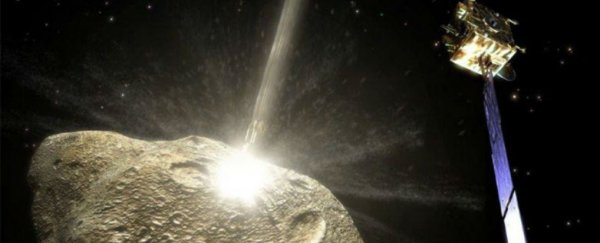Two of the world's biggest space agencies are working together to smash and deflect an asteroid, bolstering our planetary defences against rogue space rocks.
The European Space Agency (ESA) has begun preliminary work on the design of its Asteroid Impact Mission (AIM), which will send a spacecraft to scout the smaller of two asteroids in a binary system, set to pass 11 million kilometres from Earth in 2022. When it does, NASA will attempt to destroy the asteroid via a high-speed collision.
The AIM craft will be launched in 2020 and will travel to the Didymos asteroid. This 800-metre wide rock is orbited by 170-metre-wide asteroid, or moon, which has been dubbed 'Didymoon'. After impacts break up large, ancestral asteroids, smaller fragments sometimes stay entangled in binary systems such as this one.
According to the ESA, the spacecraft will "perform high-resolution visual, thermal and radar mapping of the moon to build detailed maps of its surface and interior structure."
It will also put down a lander, which the agency hopes will go as smoothly as the comet landing performed by Philae, deployed from its Rosetta spacecraft in November last year.
That, as you'll recall, was a roaring success. But it also touched down on a space rock 23 times larger than the Didymoon, so inevitably, there will be lots of nail-biting in the lead-up to this second landing.
The AIM craft will also dispatch two or more CubeSats to gather scientific data in the vicinity of the moon, and the team says the findings will be returned by high-capacity laser link to a ground station in the Canary Islands.
The mission is ESA's contribution to the larger, NASA-led Asteroid Impact & Deflection Assessment mission (AIDA), which is pretty self-explanatory, really.
In late 2022, the NASA Double Asteroid Redirection Test, or DART probe, will crash straight into the Didymoon at about 6 km per second, or more than 21,000 km per hour.
"AIM will be watching closely as DART hits Didymoon," said mission manager Ian Carnelli from the ESA in a press release. "In the aftermath, it will perform detailed before-and-after comparisons on the structure of the body itself, as well as its orbit, to characterise DART's kinetic impact and its consequences."
He says the results will allow lab-scale impact models to be calibrated on a large-scale basis, to better assess how an asteroid would react to this kind of energy.
Carnelli says if the mission is successful in deflecting the asteroid, it "will mark the first time humanity has altered the dynamics of the Solar System in a measurable way."
"It will also give us a baseline for planning any future planetary defence strategies. We will gain insight into the kind of force needed to shift the orbit of any incoming asteroid, and better understand how the technique could be applied if a real threat were to occur."
Last week, we wrote about NASA's plan to scoop a boulder from the surface of an asteroid using a robotic craft with a claw. This mission may seem equally ambitious, but it has been done before. In 2005, NASA's Deep Impact spacecraft shot a copper impactor into the comet Tempel 1. But again, that was a much larger target.
Still, the Didymoon shouldn't be scoffed at. It's three times larger than the body thought to have caused the 1908 Tunguska impact in Siberia, which is the largest impact in recorded history. And according to the ESA, an "equivalent asteroid striking Earth would be well into the 'city-killer' class, leaving a crater of at least 2.5 km across and causing serious regional and climate damage."
Luckily, it's not on a collision course with Earth.
